Acanthocephala may refer to:
- Acanthocephala is a phylum of parasitic platyzoan "worms".*
- Acanthocephala (bug) is a genus of Coreidae (leaf-footed bugs)
- A former cactus genus now a junior synonym of Parodia
Acanthocephala may refer to:
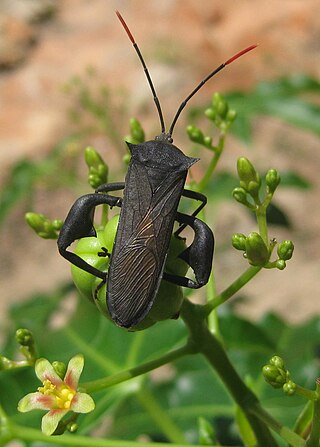
Coreidae is a large family of predominantly sap-sucking insects in the Hemipteran suborder Heteroptera. The name "Coreidae" derives from the genus Coreus, which derives from the Ancient Greek κόρις (kóris) meaning bedbug.
Archiacanthocephala is a class within the phylum of Acanthocephala. They are parasitic worms that attach themselves to the intestinal wall of terrestrial vertebrates, including humans. They are characterised by the body wall and the lemnisci, which have nuclei that divide without spindle formation, or the appearance of chromosomes, or it has a few amoebae-like giant nuclei. Typically, there are eight separate cement glands in the male, which is one of the few ways to distinguish the dorsal and ventral sides of these organisms.
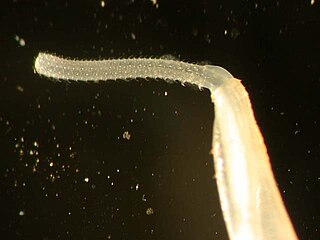
Palaeacanthocephala is a class within the phylum Acanthocephala. The adults of these parasitic platyzoans feed mainly on fish, aquatic birds and mammals. This order is characterized by the presence of lateral longitudinal lacunar canals and a double-walled proboscis receptacle. The nuclei of the hypodermis are fragmented and the males have two to seven cement glands, unlike their relatives the Archiacanthocephala, which always have eight.
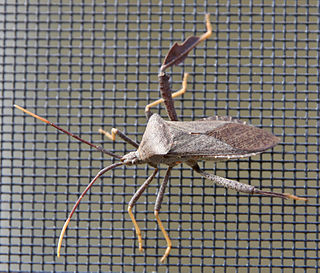
The Florida leaf-footed bug is a species of insect. The genus name Acanthocephala means "spiny head" and comes from the pointed tylus at the tip of the head. Acanthocephala femorata is found in the continental United States and Mexico.

Traumatic insemination, also known as hypodermic insemination, is the mating practice in some species of invertebrates in which the male pierces the female's abdomen with his aedeagus and injects his sperm through the wound into her abdominal cavity (hemocoel). The sperm diffuses through the female's hemolymph, reaching the ovaries and resulting in fertilization.
Apororhynchus is a genus of small parasitic spiny-headed worms. It is the only genus in the family Apororhynchidae, which in turn is the only member of the order Apororhynchida. A lack of features commonly found in the phylum Acanthocephala suggests an evolutionary branching from the other three orders of class Archiacanthocephala; however no genetic analysis has been completed to determine the evolutionary relationship between species. The distinguishing features of this order among archiacanthocephalans is a highly enlarged proboscis which contain small hooks. The musculature around the proboscis is also structured differently in this order. This genus contains six species that are distributed globally, being collected sporadically in Hawaii, Europe, North America, South America, and Asia. These worms exclusively parasitize birds by attaching themselves around the cloaca using their hook-covered proboscis. The bird hosts are of different orders, including owls, waders, and passerines. Infestation by an Apororhynchus species may cause enteritis and anemia.
Gigantorhynchida is an order containing a single family, Gigantorhynchidae of parasitic worms that attach themselves to the intestinal wall of terrestrial vertebrates. Gigantorhynchida contains the following three genera:
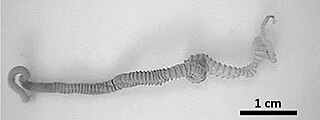
Gigantorhynchus is a genus of Acanthocephala that parasitize marsupials, anteaters, and possibly baboons by attaching themselves to the intestines using their hook-covered proboscis. Their life cycle includes an egg stage found in host feces, a cystacanth (larval) stage in an intermediate host such as termites, and an adult stage where cystacanths mature in the intestines of the host. This genus is characterized by a cylindrical proboscis with a crown of robust hooks at the apex followed by numerous small hooks on the rest of the proboscis, a long body with pseudosegmentation, filiform lemnisci, and ellipsoid testes. The largest known specimen is the female G. ortizi with a length of around 240 millimetres (9.4 in) and a width of 2 millimetres (0.08 in). Genetic analysis on one species of Gigantorhynchus places it with the related genus Mediorhynchus in the family Gigantorhynchidae. Six species in this genus are distributed across Central and South America and possibly Zimbabwe. Infestation by a Gigantorhynchus species may cause partial obstructions of the intestines, severe lesions of the intestinal wall, and may lead to death.
Mediorhynchus is a genus of small parasitic spiny-headed worms. Phylogenetic analysis has been conducted on two known species of Mediorhynchus and confirmed the placement along with the related genus Gigantorhynchus in the family Gigantorhynchida. The distinguishing features of this order among archiacanthocephalans is a divided proboscis. This genus contains fifty-eight species that are distributed globally. These worms exclusively parasitize birds by attaching themselves around the cloaca using their hook-covered proboscis. The bird hosts are of different orders.

Moniliformidae is a family of parasitic spiny-headed worms. It is the only family in the Moniliformida order and contains three genera: Australiformis containing a single species, Moniliformis containing eighteen species and Promoniliformis containing a single species. Genetic analysis have determined that the clade is monophyletic despite being distributed globally. These worms primarily parasitize mammals, including humans in the case of Moniliformis moniliformis, and occasionally birds by attaching themselves into the intestinal wall using their hook-covered proboscis. The intermediate hosts are mostly cockroaches. The distinguishing features of this order among archiacanthocephalans is the presence of a cylindrical proboscis with long rows of hooks with posteriorly directed roots and proboscis retractor muscles that pierce both the posterior and ventral end or just posterior end of the receptacle. Infestation with Monoliformida species can cause moniliformiasis, an intestinal condition characterized as causing lesions, intestinal distension, perforated ulcers, enteritis, gastritis, crypt hypertrophy, goblet cell hyperplasia, and blockages.

Oligacanthorhynchida is an order containing a single parasitic worm family, Oligacanthorhynchidae, that attach themselves to the intestinal wall of terrestrial vertebrates.

Rhadinorhynchidae is a family of parasitic worms from the order Echinorhynchida.
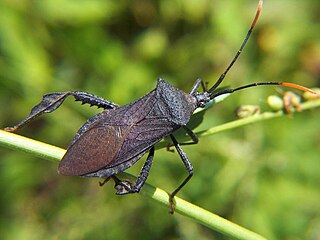
Acanthocephala, also known as spine-headed bugs, is a New World genus of true bugs in the family Coreidae. The scientific name is derived from the Greek ἄκανθα (akantha) meaning "thorn/spine" and κεφαλή (kephale) meaning "head". This name refers to the diagnostic spine on the front of the head.

Acanthocephala declivis, the giant leaf-footed bug, is a species of North American true bugs with a range from the southern United States to Guatemala and some Caribbean islands. It is the largest of this genus within this range, generally growing to be 28 to 34 mm long. It can be distinguished from similar species by its much more broadly expanding pronotum, which extends much further than the abdomen, and the blunt tubercles on the midline of the anterior pronotal lobe, which is not present in other Acanthocephala species within its range.

Acanthocephala terminalis is a species of leaf-footed bug in the family Coreidae. It is found in North America.

Acanthocephala thomasi, the giant agave bug, is a species of leaf-footed bug in the family Coreidae. It is found in Central America and North America.

Pachysentis is a genus in Acanthocephala that parasitize primates and carnivorans. They are distributed across Africa, the Middle East, and the Americas. Pachysentis species attach themselves to the inner lining of the gastrointestinal tract of their hosts using their hook-covered proboscis. Their life cycle includes an egg stage found in host feces, a cystacanth (larval) stage in an intermediate host such as the Egyptian cobra, and an adult stage where cystacanths mature in the intestines of the host. This genus appears identical to the closely related Oncicola apart from a greater number of hooks on the proboscis. There are eleven species assigned to this genus, although P. septemserialis is of uncertain taxonomic status. The female worms range from 12 millimetres (0.47 in) long and 1.6 millimetres (0.063 in) wide in P. lauroi to 50 millimetres (2.0 in) long and 4 millimetres (0.16 in) wide in P. dollfusi. Virtually all of the length is the trunk, with a short proboscis. There is pronounced sexual dimorphism in this species as females are around twice the size of the males.
Leptodema is a small genus of African bugs in the family Reduviidae. As of April 2020, the Integrated Taxonomic Information System lists nine species in the genus Leptodema:

Acanthocephala latipes is a species of leaf-footed bug in the family Coreidae. It is found in Central and South America.
Acanthocephala alata is a species of leaf-footed bug in the family Coreidae. It is native to Mexico and can be found from Texas to Colombia.